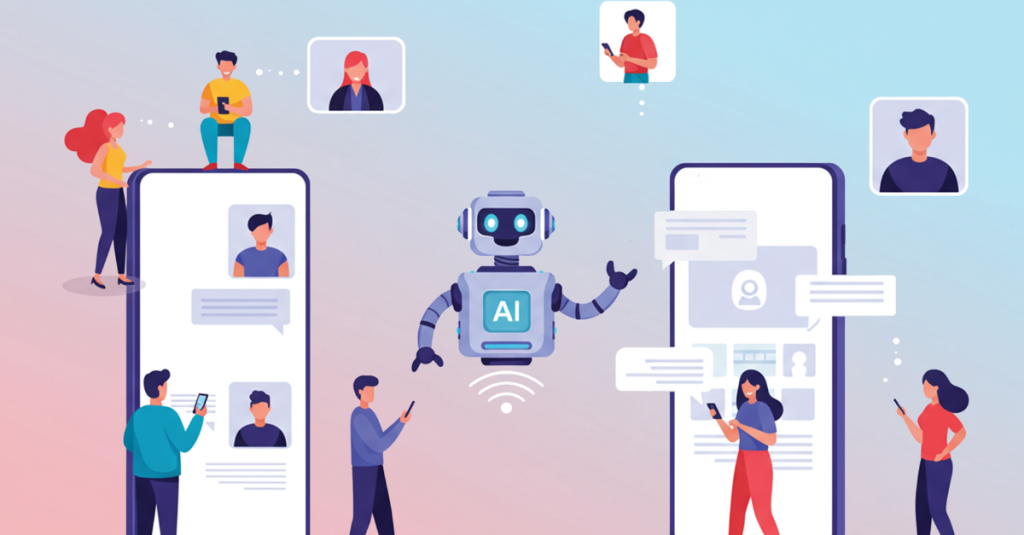Artificial intelligence (AI) has significantly changed the field of media planning, providing tools that improve efficiency, reduce workload, and offer deeper analytical insights. However, while the possibilities are exciting, AI isn’t without its challenges, and one concerning one is loss of creativity and human touch.

Creativity Challenges
AI’s ability to replicate human interaction is impressive. It can generate blog posts, scripts, and even voiceovers with a high degree of accuracy. However, while AI excels at automation, it often struggles to produce original and emotionally engaging content. (Morris, 2024)
Meta’s AI recently announced the access to tools and the ability to eliminate the need for creative input, focusing solely on performance data (Williams, 2025 & Ashley, 2025). While this approach may save time, it risks producing campaigns that are generic and fail to stand out in a competitive market. Such outputs often lack the originality and emotional depth needed to connect with audiences, potentially undermining brand loyalty and long-term success.
Research shows that audiences, particularly younger consumers, increasingly seek content that feels genuinely human, valuing personal connection and real experiences (Birch, 2025).
(Birch, 2025)
Nicole Bond (2024) highlights the importance of moving beyond efficiency-driven AI use to create individualised experiences that retain human insight. By ensuring that campaigns are shaped and refined by human creativity, media planners can produce content that engages audiences and meets brand objectives.
AI Campaign Language
Advances in natural language processing (NLP) have allowed AI to personalise communication by predicting consumer needs and crafting targeted messages. However, this shift towards automated communication has also changed the way brands use language.
AI-generated content often relies on terms like “leveraging,” “empower,” “unleash,” and “elevate.” While these words are intended to inspire, their overuse can make brand messaging feel repetitive and impersonal. This predictability can lead to scepticism among consumers, with a recent survey showing that 67% of people are likely to disengage from brands they perceive as inauthentic (Spence 2025).
Over-reliance on AI-generated language also risks reducing the role of media planners in the creative process. By delegating key tasks to AI, planners miss opportunities to develop their skills and create campaigns that reflect cultural and emotional nuances. As Joe Birch (2025) advises, media planners should use AI as a tool to support their work, not as a replacement for human judgement and creativity, or risk losing key marketing skills.
Distrust in AI
Consumer trust in AI remains a significant issue.
(Joe Birch, 2025)
According to Joe Birch (2025), 92% of consumers express concerns about the ethical implications of AI, and over half of under-35s worry that AI will make their jobs obsolete (Birch 2025). This distrust is often linked to the perception that AI shortcuts the creative process, reducing the effort and authenticity traditionally associated with media planning.
To address these concerns, transparency is essential. Media planners must clearly explain how AI is used to enhance campaigns without replacing human creativity. For example, Vaseline’s See My Skin initiative used AI to address bias in dermatological resources, demonstrating how technology can solve real-world problems while maintaining a human-centred approach.
(Vaseline, 2023)
By showing that AI is a tool to improve outcomes rather than replace human effort, brands can rebuild trust and strengthen their connection with consumers.
AI Bias
AI systems are shaped by the data they are trained on, and biased data can lead to discriminatory outcomes. This is a significant challenge in media planning, where algorithms can unintentionally exclude certain audiences. For instance, dermatology algorithms have been shown to favour lighter skin tones unless corrective measures are taken (Spence, 2025).
Addressing AI bias requires proactive measures. High-performing organisations are already prioritising diversity in their AI systems, with studies showing that such efforts increase the likelihood of successful outcomes by 29% (Williams, 2025). Media planners must adopt similar practices, auditing AI algorithms to ensure they are inclusive and fair. This involves diversifying data inputs and maintaining ethical oversight to avoid bias and ensure campaigns reach all segments of the audience.
How to overcome the challenges
To overcome AI challenges in media planning, planners should:
- Use AI for repetitive tasks while keeping creativity and judgement central.
- Leverage AI to inspire ideas and enhance human-focused campaigns.
- Refine AI outputs to align with brand values and audience needs.
- Be transparent about AI’s role in supporting, not replacing, human effort.
- Audit AI systems to address bias and ensure inclusivity, while developing skills to balance AI with human expertise.
By adopting these strategies, planners can deliver campaigns that are efficient, creative, authentic, and impactful.
Leave a Reply